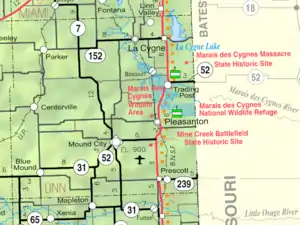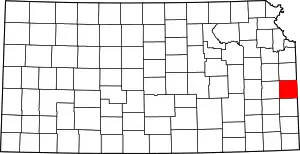Linn Valley, Kansas
Linn Valley is a city in Linn County, Kansas, United States. As of the 2010 census, the city population was 804.[5]
Linn Valley, Kansas | |
|---|---|
 Location within Linn County and Kansas | |
 KDOT map of Linn County (legend) | |
| Coordinates: 38°22′39″N 94°42′33″W | |
| Country | United States |
| State | Kansas |
| County | Linn |
| Founded | 1970s |
| Incorporated | 1998 |
| Area | |
| • Total | 3.21 sq mi (8.32 km2) |
| • Land | 2.96 sq mi (7.66 km2) |
| • Water | 0.25 sq mi (0.65 km2) |
| Elevation | 896 ft (273 m) |
| Population | |
| • Total | 804 |
| • Estimate (2019)[3] | 868 |
| • Density | 293.44/sq mi (113.28/km2) |
| Time zone | UTC-6 (CST) |
| • Summer (DST) | UTC-5 (CDT) |
| ZIP code | 66040 |
| Area code | 913 |
| FIPS code | 20-41465 |
| GNIS ID | 1852215 [4] |
| Website | cityoflinnvalley.com |
History
Linn Valley had its start in the 1970s as a planned community centered around a lake.[6] It was incorporated as a city in 1998.[7]
Geography
Linn Valley is located at 38°22′39″N 94°42′33″W (38.377582, -94.709143).[8] According to the United States Census Bureau, the city has a total area of 2.97 square miles (7.69 km2), of which, 2.72 square miles (7.04 km2) is land and 0.25 square miles (0.65 km2) is water.[9] All but about 200 acres (0.81 km2) of the City is within the private closed community of Linn Valley Lakes.
Demographics
| Historical population | |||
|---|---|---|---|
| Census | Pop. | %± | |
| 2000 | 562 | — | |
| 2010 | 804 | 43.1% | |
| 2019 (est.) | 868 | [3] | 8.0% |
| U.S. Decennial Census[10] | |||
2010 census
As of the census[2] of 2010, there were 804 people, 360 households, and 255 families residing in the city. The population density was 295.6 inhabitants per square mile (114.1/km2). There were 697 housing units at an average density of 256.3 per square mile (99.0/km2). The racial makeup of the city was 96.1% White, 0.1% African American, 1.2% Native American, 0.4% Asian, 0.1% from other races, and 2.0% from two or more races. Hispanic or Latino of any race were 1.4% of the population.
There were 360 households, of which 21.7% had children under the age of 18 living with them, 59.7% were married couples living together, 6.4% had a female householder with no husband present, 4.7% had a male householder with no wife present, and 29.2% were non-families. 27.5% of all households were made up of individuals, and 10% had someone living alone who was 65 years of age or older. The average household size was 2.23 and the average family size was 2.65.
The median age in the city was 50.9 years. 18.7% of residents were under the age of 18; 4% were between the ages of 18 and 24; 18.9% were from 25 to 44; 33.3% were from 45 to 64; and 25.1% were 65 years of age or older. The gender makeup of the city was 52.7% male and 47.3% female.
2000 census
As of the census of 2000, there were 562 people, 238 households, and 178 families residing in the city. The population density was 221.7 people per square mile (85.4/km2). There were 415 housing units at an average density of 163.7 per square mile (63.1/km2). The racial makeup of the city was 95.02% White, 1.60% African American, 0.53% Native American, 0.18% Asian, 0.36% from other races, and 2.31% from two or more races. Hispanic or Latino of any race were 3.56% of the population.
There were 238 households, out of which 19.3% had children under the age of 18 living with them, 70.2% were married couples living together, 2.5% had a female householder with no husband present, and 25.2% were non-families. 19.3% of all households were made up of individuals, and 9.2% had someone living alone who was 65 years of age or older. The average household size was 2.36 and the average family size was 2.67.
In the city, the population was spread out, with 19.9% under the age of 18, 5.2% from 18 to 24, 21.2% from 25 to 44, 32.7% from 45 to 64, and 21.0% who were 65 years of age or older. The median age was 48 years. For every 100 females, there were 112.9 males. For every 100 females age 18 and over, there were 108.3 males.
The median income for a household in the city was $31,094, and the median income for a family was $34,500. Males had a median income of $30,972 versus $24,375 for females. The per capita income for the city was $18,479. About 5.1% of families and 8.9% of the population were below the poverty line, including 20.4% of those under age 18 and 7.1% of those age 65 or over.
Education
The community is served by Prairie View USD 362 public school district.
References
- "2019 U.S. Gazetteer Files". United States Census Bureau. Retrieved July 24, 2020.
- "U.S. Census website". United States Census Bureau. Retrieved 2012-07-06.
- "Population and Housing Unit Estimates". United States Census Bureau. May 24, 2020. Retrieved May 27, 2020.
- "US Board on Geographic Names". United States Geological Survey. 2007-10-25. Retrieved 2008-01-31.
- "2010 City Population and Housing Occupancy Status". U.S. Census Bureau. Retrieved May 31, 2011.
- "Linn County Towns & Places - Page 2". Legends of Kansas. Archived from the original on 1 July 2014. Retrieved 13 June 2014.
- "History". City of Linn Valley, Kansas. Archived from the original on 19 December 2013. Retrieved 13 June 2014.
- "US Gazetteer files: 2010, 2000, and 1990". United States Census Bureau. 2011-02-12. Retrieved 2011-04-23.
- "US Gazetteer files 2010". United States Census Bureau. Archived from the original on 2012-07-02. Retrieved 2012-07-06.
- United States Census Bureau. "Census of Population and Housing". Retrieved October 23, 2013.
